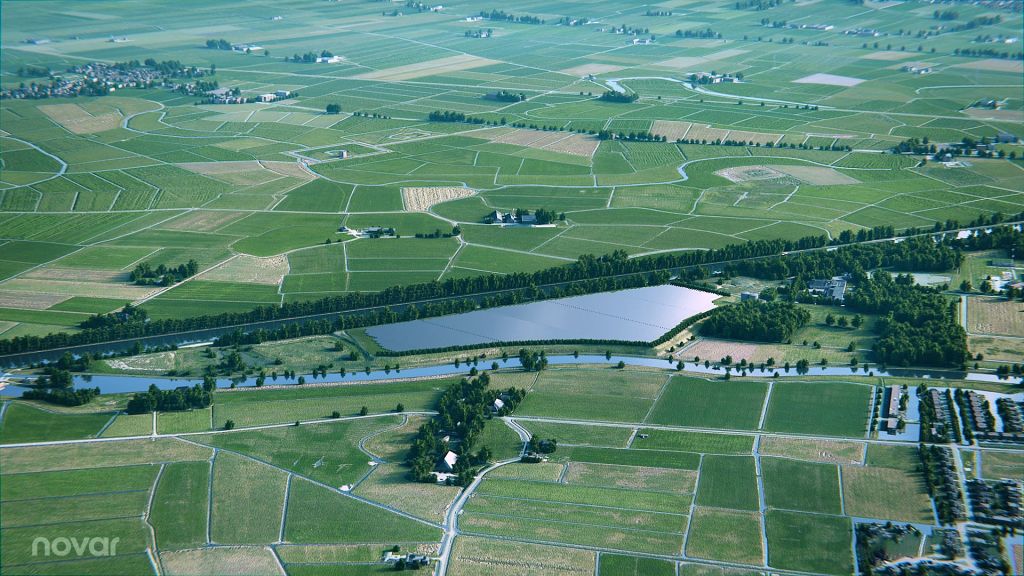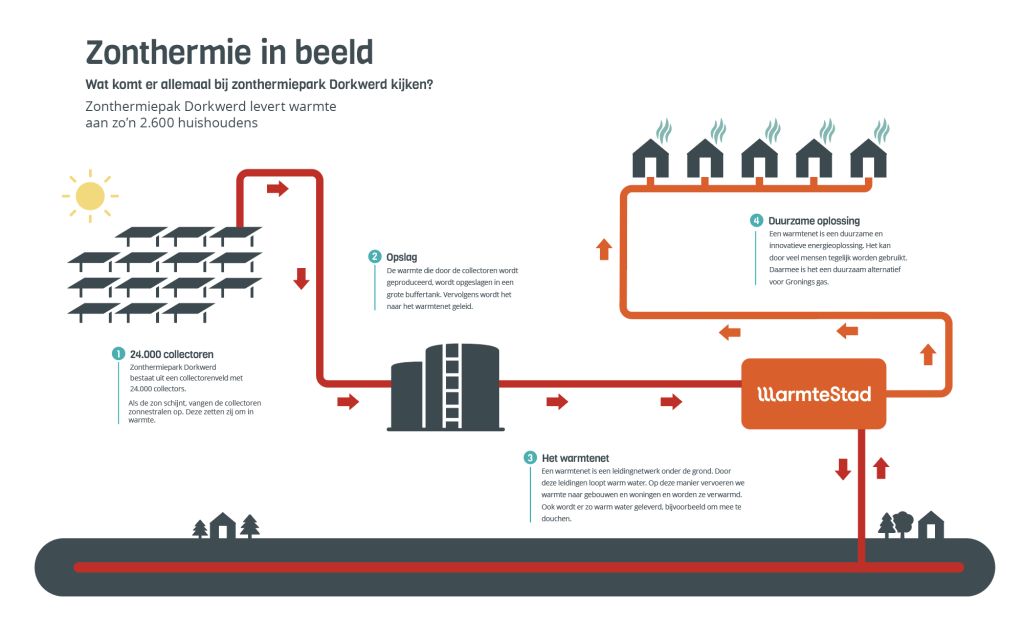
Sustainable entrepreneurs, governments, and knowledge institutions are working with all their might to make the Netherlands more sustainable. But until now they have overlooked an energy source with great potential for accelerating the energy transition: solar thermal.
With a natural gas-free and CO2-neutral Groningen as their goal, a group of innovative entrepreneurs dared to roll out this new technology on a large scale. Area developer K3, developer of green energy systems Novar - formerly Solarfields - and supplier TVP Solar form the team of driven pioneers. On K3's former dredging depot in Dorkwerd, near Groningen, the largest solar heat park in the Netherlands is rising. With an area of 12 hectares and a capacity of 25 Gigawatt hours (GWh) per year, the fourth largest in the world.
The solar thermal park will supply renewable heat to the heat grid of Groningen's renewable utility WarmteStad. 'With this, we can fully supply heat to about 2,500 to 2,600 households and businesses in Northwest Groningen,' Project Director Emile Janssens of Novar enthuses.
Utilizing the heat from the sun, directly or indirectly. And use it to heat buildings and provide hot tap water. It sounds so simple. And so it began at the end of the nineteenth century. Pioneers in the United States filled black-painted barrels with water, and then the sun did the rest of the work. Today it is a mature and extremely innovative technique. A proven technology that converts solar radiation into heat. But what makes it even more interesting is its enormous efficiency. Especially when you compare it with other renewable energy technologies. With today's solar collectors, the annual energy yield per square meter is three times that of the immensely popular PV -Photo Voltaic-, where you convert sunlight into electricity.
There are 9.6 million buildings in the Netherlands. From homes to industry. The resulting heat demand amounts to more than half of our total energy consumption. So that heat could very well come from the sun. And yet Dutch roofs are not full of solar collectors, industry still burns massive amounts of natural gas, and our heat networks run mainly on combustion plants. In the renewable energy market, PV, wind farms and biomass dominate. This popularity leaves little room for new, now smaller solutions. With a market share of 0.04 percent of the final energy supply in the Netherlands, solar thermal currently plays no significant role. And this makes the solar thermal park in Dorkwerd unique in the Netherlands. But also beyond. Countries in Europe apply solar thermal relatively little. Denmark, Greece, Italy, Spain and Germany are exceptions.
Although the idea behind the technology of solar thermal has been around for a long time, the current technology is still fairly new and therefore unknown. Experts by experience can play an important role in spreading knowledge. Among policy makers and subsidy providers, installers, sustainable entrepreneurs, and industry.
Initially, K3 and Novar also wanted to develop a solar farm on the old dredging depot in Dorkwerd. 'But when it turned out that the sustainable utility WarmteStad would be constructing a heat grid, we quickly came to the conclusion that solar thermal was the very best solution for this beautiful, but not optimally used area,' Janssens says. The presence of WarmteStad's heat grid, and the possibility of temporarily storing heat in a buffer tank right next to the solar thermal park, solved the seasonal effect for the Dorkwerd solar thermal park team. One of the challenges with solar thermal. Because with coal or gas power plants, you can turn the knobs endlessly. But many renewable energy sources you don't simply turn on or off.
A solar collector converts sunlight into heat. This is in contrast to a PV panel, also known as a solar panel. That, in fact, converts sunlight into electricity. A liquid runs along the solar collectors. Usually water, with or without an antifreeze. This liquid, heats up to more than 90 degrees Celsius on a sunny day. The solar heating system stores this renewable heat in a buffer tank. And then it directs the heat toward the heat grid.

In the Netherlands, the sun shines mainly in the summer and much less in the winter. For this reason, solar heat is particularly interesting for hot tap water. After all, you use that in the summer, too. But space heating is mainly needed in winter. And that is when less solar heat is available. Large-scale heat storage allows you to temporarily store excess heat and use it when there is demand. When you feed a heat system with a renewable heat source, such as solar thermal, you must optimally match supply and demand. This allows you to use renewable heat sources efficiently and reduce heat supply costs.
The panels Novar is using for the solar thermal park in Dorkwerd are extremely innovative and have a high efficiency because they are vacuum insulated. Janssens: 'This minimizes the heat loss between the sun's radiation and the liquid running along it. And that ensures a much higher yield per panel, than if you were to opt for a standard solar collector. It was the Swiss company TVP Solar, now also a shareholder in the project, that produced this state-of-the-art solar collector. 'They managed to convince us with the data from their own research. They did ten years of extensive testing from their own weather simulation station in Italy. Tried everything to break the panels. With hail, with stones. Investigated what it does to the yield as the panel ages. In the end, this was the best and most sustainable system.'
You would expect solar thermal to be unprofitable because the sun shines too little in the Netherlands. But the solar heat from Dorkwerd is sufficient for 25 percent of all the heat consumed by the more than 10,000 (future) connected people. Janssens: 'We supply a maximum of 93 degrees Celsius in the summer. In winter, with bad weather, rain and wind, temperatures of ten degrees below zero, the temperature of the water is still between 75 and 85 degrees Celsius. Because these panels provide enough heat for high temperatures with the slightest ray of sunlight. To reach the agreed-upon temperature, we implemented a heat buffer in the system. A buffer tank filled with 6,000 cubic meters of water, to store heat.' 'One of the great advantages of solar thermal, is that we do not suffer from grid congestion,' says Janssens excitedly. 'Because we don't supply electricity, we supply heat. And with that, a project like ours can contribute significantly to the sustainability goals of a municipality or province.'
"One of the biggest advantages of solar thermal, is that we don't have grid congestion.
The construction of a solar farm is also an opportunity to increase the natural value of the site. This is stated in the code of conduct Zon op Land. But ecology is also a spearhead for the shareholders in this project. Together with ecologists, the beekeepers association, authorities and the surrounding area, they developed an ecological design and management plan for the entire site. Of the 24-hectare dredging depot, 12 hectares are earmarked for solar thermal energy. Under the management of the province, the remaining 12 acres will receive a fully ecological layout. Animal species such as the reed warbler, pool frog, water shrew and otter will have a habitat in which they thrive. One species needs clean water, aquatic plants, and gentle banks, the other needs shrub and reed vegetation. Ample space for flora and fauna is also provided between and around the panels.
Rome wasn't built in one day. And the partners in this project can speak well of that. Because the head is off. Construction is underway. If everything goes according to plan, WarmteStad will occupy the solar thermal park by the end of 2023. But that certainly didn't happen without a struggle. Plans for a solar energy park on the former dredging depot in Dorkwerd began back in 2017. With that, it took more than six years before the first shovel went into the ground. It is a complex project. And thus an enormous challenge. Not only was the technology new and unique. It was also the first time that a private solar park was going to supply heat to a public heat network. Cooperation between public and private, automatically means a much more intensive cooperation with the government. More parties involved. Many stakeholders.
Unfamiliarity for a case like this among grant makers, banks, and insurers. 'This meant that everyone had to continually water down. And if people would please revisit version 18.8 of the same document? We had to share and explain endless project plans. And sometimes we had to initiate a subproject, without being sure that the financing was in place. Janssens can happily laugh about it now. 'There were always plenty of reasons to think: we're quitting. But we were intrinsically motivated. Cash in, adopt, and keep going. Whatever we ran into. We constantly kept the big picture in mind.'
'I dare say that as a project developer and as shareholders we have gained a tremendous amount of experience with this. The project is now profitable. Although profitability was not a threatening factor for realization of the park. 'However, the business case is marginal,' Janssens states. 'But that is mainly due to the complexity of this particular project. You will have to apply customization to a new project anyway.' Especially the available infrastructure is crucial. 'You have to be able to get rid of your heat. Suppose you build a whole new residential area in the middle of nowhere with a solar thermal park. Then you put the infrastructure underground at once. But implementing a heat network in existing neighborhoods is a lot more challenging. Both logistically and financially.
According to TNO, there is indeed a good business case for solar heat in the Netherlands. In late 2022, TNO presented the research results, after which they concluded that solar heat can play an important role in the transition to a sustainable heat supply. It also drastically reduces costs compared to gas for the end user. Solar heat in heat networks without seasonal storage is already interesting. So this offers enormous perspective in the rollout of solar heat.
For the huge project team of solar thermal park Dorkwerd, it was quite a challenge. But the result was absolutely worth it. Solar thermal is a new, innovative but proven technology. Three times more efficient than the PV system, which the roofs are full of. Solar heat can play an important role in the significant heat demand, which accounts for more than half of final energy consumption. Solar thermal deserves a place among the now even larger renewable energy solutions. Knowledge and even more innovation is elementary to success.
This article previously appeared on topsectorenergie.nl.


